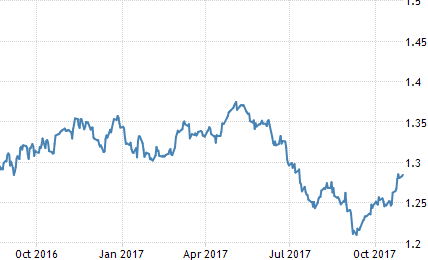The Canadian Dollar Speaks Volumes On The Future Path Of Interest Rates
It was just a matter of a six months ago that everything was coming up roses for the Canadian economy. Bank analysts were singing its praises as the annual rate of GDP expanded by over 4% in the first of the half of 2017, the best performance of any G-7 countries. In response to this performance, the loonie took flight ( no pun intended) from 1. 36 to 1.21 (usd/cdn) over the summer months. Prompted by evidence that the economy is well on the way to recovery from the “oil shock” of 2014-15, the Bank of Canada moved swiftly, raising the bank rate by 25pbs in July and again in September. Overall the mood was one of optimism and confidence that monetary policy could return to more normal conditions, after nearly a decade of near -zero rates.
But something happened during the late summer and early fall that signalled that all is not well.[1] Growth came to a sudden halt. During the summer months, key sectors, such as manufacturing, residential construction, and transportation fell, resulting in GDP remaining flat for the month of July. Today Statistics Canada released data confirming the presence of further weakness. The Canadian economy unexpectedly shrank by 0.1 percent in August, the first decline in almost a year. Most notably were the declines in manufacturing and in the mining and oil/gas industries. By far, the most worrisome aspect is the 10% decline in exports for the months of June, July and August. Further proof of a sagging economy is found in the prices paid by producers which fell 0.3 percent in September from August. Both data series are moving in the wrong direction from that forecasted by industry analysts. Remember these data do not reflect the full impact of the recent two bank rate increases which have yet to work their way through the economy.
No wonder the Bank adopted a stand-pat position on rate hikes, preferring to rely on in-coming data, rather than charting a prescribed path. Last week the Bank of Canada lowered its estimate for third-quarter annualized growth to 1.8 percent from 2.0 percent and said it would be more cautious about further rate hikes.
Figure 1 USD/CDN

So what happens to an economy that shifts abruptly, almost in midstream? Its currency starts to reverse course just as abruptly (Figure 1). Now, analysts are out in full force calling for the loonie to decline further, even to retreat to a previous low of 1.33 within six months.[2] An important overlay driving the loonie down is the growing concern that the NAFTA talks will not end well for both the United States and Canada.
The weakness in the loonie is signalling that the Bank of Canada will be on hold, most likely for the balance of the year.
[1] http://www.talkmarkets.com/content/global-markets/the-canadian-economy-cools-down-quickly?post=151114
[2] https://economics.cibccm.com/economicsweb/cds?ID=4010&TYPE=EC_PDF
Disclosure: None.




I give Canada credit for trying to start to normalize rates. The abnormally low rates across the globe makes it hard for any one country to normalize themselves. That said, the one closest to normalization when the next downturn comes will be the best off. So there is a good reason to try.
A valid point. That said, what has changed is what is normal. The EU is doing well with negative rates, so that suggests that North America could fight the next recession with negative rates, abhorrent as that sounds.